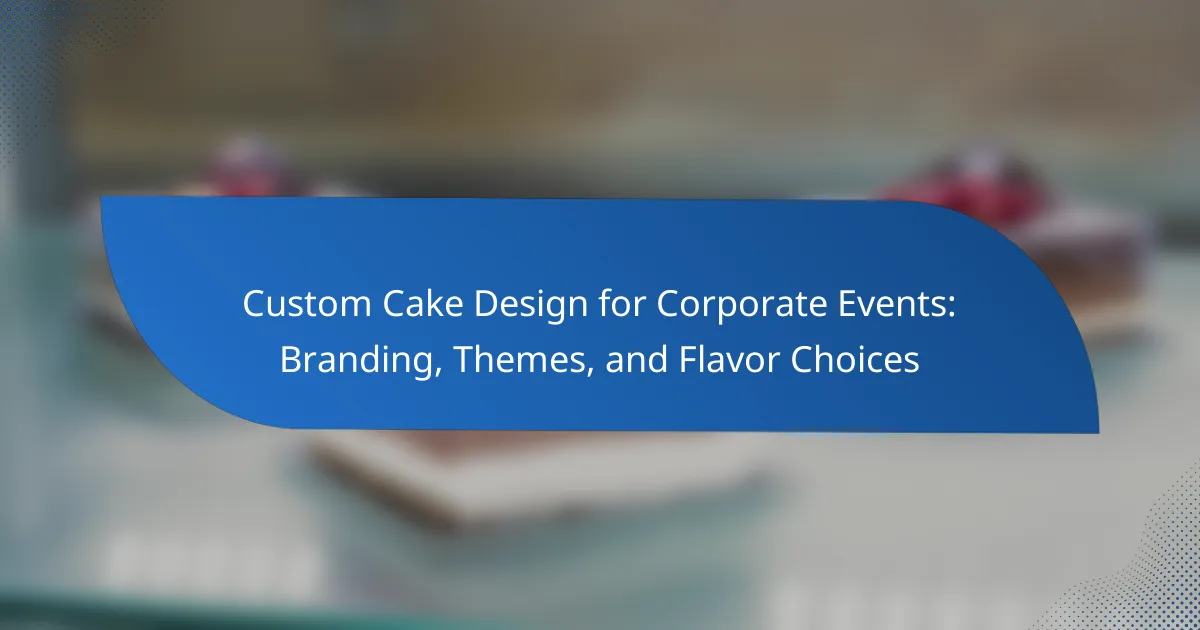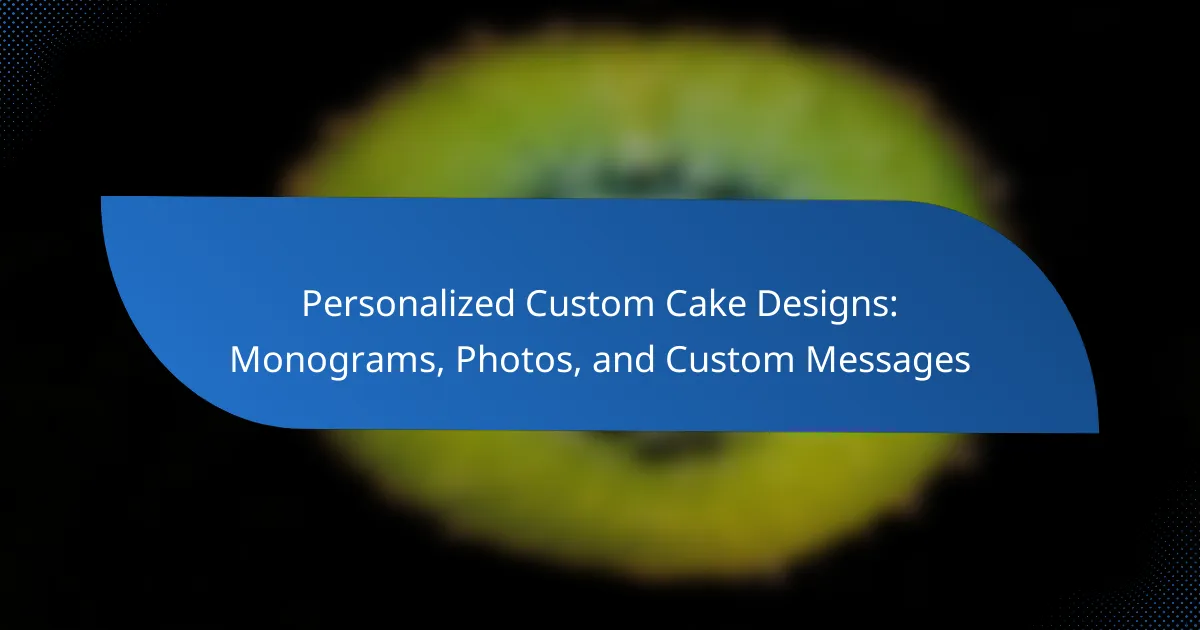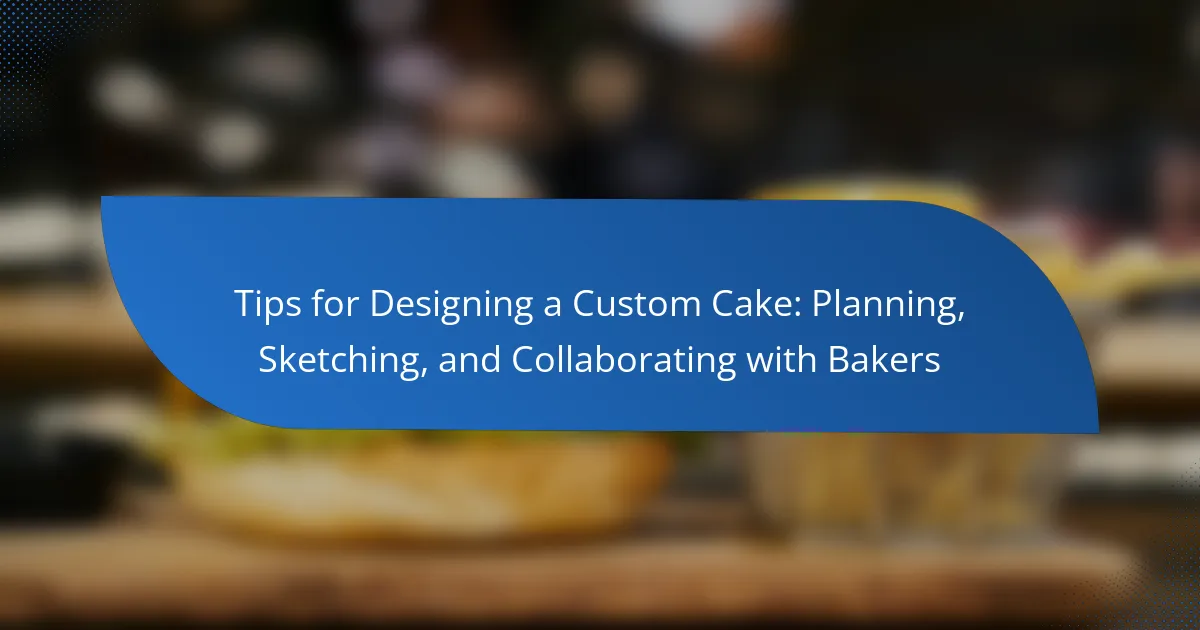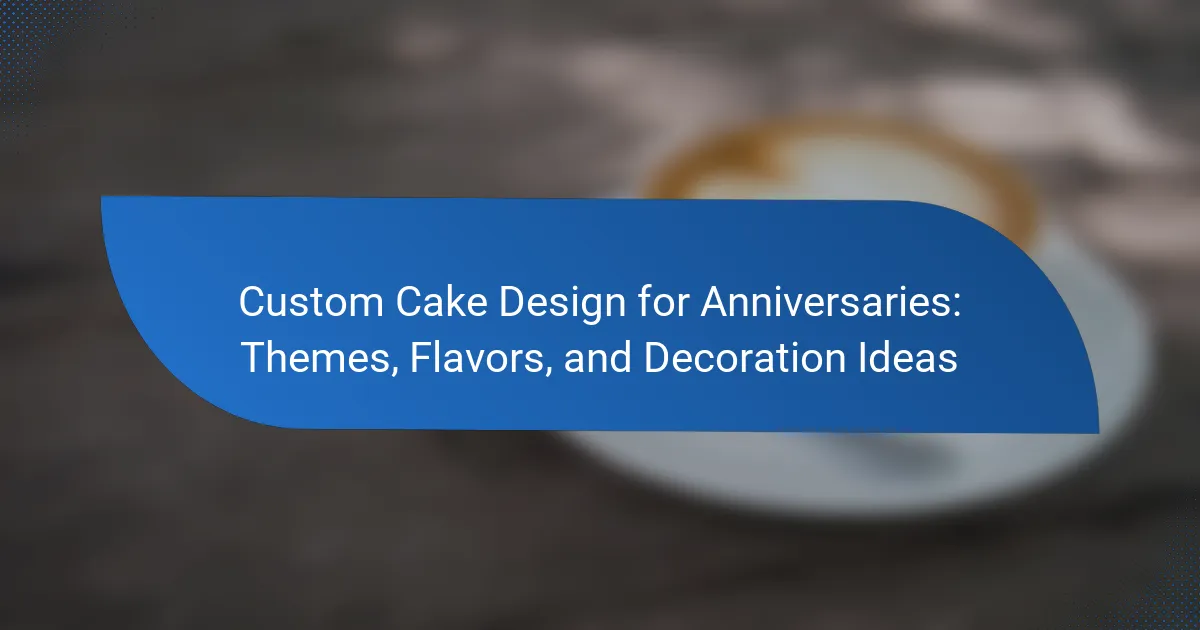Custom cake design is a structured process that involves several key stages: consultation, tasting, design conceptualization, and delivery. The process begins with a consultation where clients share their vision, preferences, and dietary restrictions. Following this, a tasting session allows clients to sample various flavors, helping to finalize the cake’s taste profile. After the tasting, bakers create design sketches or digital mock-ups for client approval. The final stage involves timely delivery of the completed cake, ensuring freshness for the event. Clear communication throughout these stages is essential for achieving a personalized and satisfying cake design experience.

What is the Process of Custom Cake Design?
The process of custom cake design involves several key steps. It typically starts with a consultation. During this meeting, clients discuss their vision and preferences. Bakers gather details about themes, flavors, and dietary restrictions. Next, a tasting session occurs. Clients sample various cake flavors and fillings. This step helps finalize the taste profile. After the tasting, the design is conceptualized. Bakers create sketches or digital mock-ups. Clients review and approve the design. Finally, the cake is prepared and delivered. Timely delivery ensures the cake arrives fresh for the event. This structured approach guarantees a personalized and satisfying cake design experience.
How does the consultation phase work in custom cake design?
The consultation phase in custom cake design involves a meeting between the client and the cake designer. During this phase, clients discuss their vision, preferences, and any specific themes or occasions for the cake. The designer gathers information about the desired flavors, sizes, and any dietary restrictions. Visual aids, such as portfolios or sample cakes, may be presented to inspire ideas. This phase allows for collaboration and ensures that the designer understands the client’s expectations. Ultimately, a detailed proposal or sketch may be created based on the discussion, setting the foundation for the next steps in the cake design process.
What key information is gathered during the consultation?
Key information gathered during the consultation includes the client’s preferences, event details, and budget. The client’s preferences cover flavor, design, and dietary restrictions. Event details involve the date, location, and number of guests. The budget helps in determining the scope of the design and ingredients. This information ensures that the custom cake aligns with the client’s vision and requirements. Gathering these details allows for a tailored cake design that meets expectations.
How can clients prepare for the consultation?
Clients can prepare for the consultation by gathering their ideas and preferences. They should consider the occasion and theme for the cake. Clients can also bring inspiration images to illustrate their vision. It is helpful to have a budget range in mind for the cake. Clients should think about specific flavors and dietary restrictions. Additionally, they can list any must-have design elements or colors. Having a guest count will assist in determining cake size. Finally, clients should be ready to discuss their timeline for delivery.
What role does the tasting play in custom cake design?
Tasting plays a crucial role in custom cake design. It allows clients to sample different flavors and textures. This step helps clients make informed decisions about their cake preferences. During the tasting, bakers can showcase their skills and creativity. Clients can provide feedback on flavor combinations and designs. This interaction fosters collaboration between the client and the baker. The tasting experience can significantly influence the final cake design. Ultimately, it ensures that the cake meets the client’s expectations and desires.
What types of flavors and designs are typically available for tasting?
Common flavors available for tasting include vanilla, chocolate, red velvet, and lemon. These flavors are popular due to their classic appeal. Unique flavors may also be offered, such as lavender, salted caramel, and almond. Each flavor can be paired with various fillings and frostings for added variety.
Designs typically available for tasting include simple buttercream finishes, fondant-covered cakes, and intricate themed decorations. Cakes may feature floral designs, geometric patterns, or personalized elements. Customization options allow clients to choose designs that reflect their preferences. This variety ensures that clients can find a cake that suits their event’s theme and taste.
How does the tasting influence the final cake design?
Tasting significantly influences the final cake design by providing feedback on flavor preferences. During the tasting, clients experience different cake flavors and textures. This direct interaction helps identify which combinations resonate best. The feedback received informs adjustments in flavor profiles, ensuring the final product aligns with client expectations. Additionally, the tasting can inspire visual elements based on flavor themes. For instance, a rich chocolate flavor may lead to a more decadent design. Ultimately, the tasting process creates a collaborative environment that enhances the overall cake design.
What are the logistics involved in the delivery of custom cakes?
The logistics involved in the delivery of custom cakes include careful planning and execution. First, the cake must be securely packaged to prevent damage during transport. Delivery vehicles should be equipped with temperature control to maintain cake integrity. Scheduling delivery times is crucial to ensure freshness upon arrival. Routes should be planned to minimize travel time and avoid delays. Communication with the recipient is essential for a smooth handoff. Finally, drivers must be trained in handling delicate items to ensure safe delivery. These steps collectively ensure that custom cakes arrive in perfect condition for the celebration.
How is the cake transported to ensure it arrives in perfect condition?
Cakes are transported using secure packaging and stable transportation methods to maintain their condition. Sturdy cake boxes are utilized to prevent movement during transit. Cakes are often placed on a flat, non-slip surface to avoid shifting. Refrigerated vehicles may be used for perishable cakes to control temperature. Additionally, cushioning materials can be added to absorb shocks. Delivery personnel are trained to handle cakes carefully and avoid sudden movements. These methods collectively ensure that cakes arrive intact and visually appealing.
What factors are considered when scheduling the delivery?
Delivery scheduling considers several key factors. These include customer availability, delivery location, and order complexity. Customer availability ensures someone is present to receive the cake. Delivery location impacts travel time and logistics. Order complexity involves the size and design of the cake, which may require special handling. Additionally, timing for events, such as weddings or parties, is critical for ensuring freshness. Weather conditions can also affect delivery schedules, especially in extreme cases. Lastly, communication with the customer is essential to confirm all details and preferences.

How do the stages of custom cake design connect?
The stages of custom cake design connect through a sequential process that ensures client satisfaction. The consultation stage establishes the client’s vision and preferences. This stage informs the subsequent tasting phase, where flavor options are presented based on the initial discussion. Feedback from the tasting helps refine the design and flavors to meet client expectations. Finally, the delivery stage brings the completed cake to the client, integrating all previous stages. Each stage relies on the outcomes of the prior one, creating a cohesive design experience. This structured approach enhances communication and ensures a personalized final product.
Why is effective communication important during each phase?
Effective communication is crucial during each phase of custom cake design. It ensures that client expectations align with the cake designer’s capabilities. During the consultation phase, clear dialogue helps in understanding the client’s vision and preferences. This reduces the risk of misunderstandings later in the process. In the tasting phase, effective communication allows for feedback on flavors and designs. Clients can express their likes and dislikes, guiding adjustments before finalization. Finally, during the delivery phase, clear instructions ensure the cake arrives safely and on time. Miscommunication at this stage can lead to delivery errors, impacting the overall experience. Studies show that effective communication improves customer satisfaction and loyalty in service industries.
How do client preferences shape the overall design process?
Client preferences significantly influence the overall design process of custom cakes. They determine the flavor, design, and presentation of the cake. During consultations, clients express their desires and expectations. This input guides the baker in creating tailored options. Preferences also affect ingredient choices and dietary restrictions. For example, a client may request gluten-free or vegan options. Additionally, aesthetic preferences shape the visual elements of the cake. These can include color schemes, themes, and decorations. Ultimately, aligning the design with client preferences ensures satisfaction and enhances the overall experience.

What are the best practices for a successful custom cake design experience?
Clear communication with the cake designer is essential for a successful custom cake design experience. Discuss your vision, themes, and preferences in detail. Provide reference images to illustrate your ideas. Be open to the designer’s suggestions and expertise. Establish a timeline for the project, including consultation, tasting, and delivery dates. Confirm dietary restrictions and preferences early in the process. Ensure that you agree on pricing and any additional costs upfront. Request a contract that outlines all details to avoid misunderstandings. Following these practices ensures a smooth and enjoyable custom cake design experience.
What tips can clients follow to enhance their custom cake design process?
Clients can enhance their custom cake design process by clearly communicating their vision. Providing reference images helps convey specific styles and ideas. Discussing dietary restrictions ensures that the cake meets all needs. Setting a realistic budget allows the designer to create within financial limits. Scheduling tasting sessions provides an opportunity to select flavors. Asking about design timelines helps manage expectations. Being open to suggestions can lead to innovative design ideas. Finally, confirming details in writing ensures all parties are aligned.
How can clients effectively express their vision for the cake?
Clients can effectively express their vision for the cake by providing clear and detailed descriptions. They should outline their preferred flavors, colors, and themes. Visual aids, such as reference images or mood boards, can enhance communication. Clients should also specify any dietary restrictions or preferences. Discussing the occasion and desired cake size is crucial. Open dialogue with the cake designer fosters understanding. Regular feedback throughout the design process ensures alignment with the client’s vision. This collaborative approach leads to a more satisfying final product.
What common mistakes should clients avoid during the process?
Clients should avoid being vague about their preferences during the custom cake design process. Clear communication is essential for achieving the desired outcome. Clients often make the mistake of underestimating the importance of details, such as flavor combinations and design elements. Providing specific examples or references can guide the designer effectively. Another common mistake is neglecting to discuss budget constraints upfront. This can lead to misaligned expectations regarding the final product. Additionally, clients sometimes overlook the timeline for cake orders. Placing orders too close to the event date can limit options and availability. Lastly, clients may fail to ask about ingredient sourcing and dietary restrictions. Understanding these factors ensures that the cake meets all guests’ needs.
The main entity of the article is the custom cake design process. This article outlines the key stages involved, including the consultation phase where client preferences and event details are gathered, the tasting session for flavor selection, and the logistics of cake delivery. It emphasizes the importance of effective communication throughout these stages to ensure client satisfaction and alignment with their vision. Additionally, the article provides best practices and tips for clients to enhance their custom cake design experience, highlighting common mistakes to avoid.



